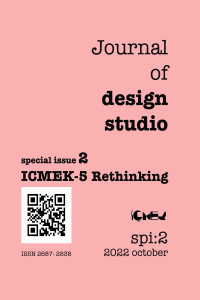Evaluation of Distance Education and Formal Education on Architectural Design Studio Practices and Student Perception with Comparative Analysis: Antalya Bilim University
Evaluation of Distance Education and Formal Education on Architectural Design Studio Practices and Student Perception with Comparative Analysis: Antalya Bilim University
distance education, Architectural design studio, Education ISO quality, Distance education.,
___
- Ahmad, L, Sosa, M, Musfy, K (2020) Interior design teaching methodology during the global COVID-19 pandemic. Interiority 3(2): 163–184.
- Akyıldız, E. C. (2020), Bir Öğrenme Ortamı Olarak Tasarım Stüdyosu: Maltepe Üniversitesi Tasarım Stüdyosu 1 Deneyimi, The Turkish Online Journal of Design, Art and Communication – TOJDAC, ISSN: 2146-5193, October 2020 Volume 10 Issue 4, p.389-407 .
- Anthony, K. H., (2012) “Studio Culture and Student Life", Architecture School Three Centuries of Educating Architects in North America, MIT Press, 396-401.
- Aslan, D. (2016),Mimari Stüdyo Kültürü ve Pratik Üzerine, Ege Mimarlık ,s.12-14.
- Aydın, F. (2013). İç Denetim Birimi Yöneticilerinin Kalite Güvence Ve Geliştirme Programındaki Rolü. Denetişim, (12), 21-24.
- Aydınlı, S. (2015), Tasarım Eğitiminde Yapılandırıcı Paradigma: ‘Öğrenmeyi Öğrenme, Tasarım+Kuram, Sayı 20.
- Ayvaz, B., Kuşakçı, A. O., & Borat, O. (2016). Kalite güvencesi ve akreditasyon süreçleri. Yeni Türkiye, 88, 1-8.
- Balamir, A.K.,(1985) Mimarlık Söyleminin Değişimi ve Eğitim Programları, Mimarlık, 218 23/8, s.9-15.
- Bulduklu, Yasin (2019) Eleştirel Çalışmalarda Nitel Araştırma Yöntemi Olarak Gömülü Teori, Kritik İletişim Çalışmaları Dergisi
- Cohen, Louis; Manion, Lawrence; Morrison, Keith (2007). Research Methods in Education, Routledge Taylor & Francis Group, This edition published in the Taylor & Francis e-Library, 2007.
- Collier, David (1993), The comparative Method political science: The state of the discipline II. Washington DC. American political science Association.
- Celik, C.; Arabacıoğlu B. (2022), İç Mimarlık Eğitimi Stüdyo Derslerinin Gelişimi Işığında Ölçekler Arası Tasarım Yaklaşımı Üzerine Güncel Bir Çalışma, bāb Journal of FSMVU Faculty of Architecture and Design, Cilt 3, Sayı 2, 190 – 208.
- Eceoğlu, A. (2012). Teknolojik Gelişmelerin Mimarlık Mesleğine Yansımalari Ve Simülasyon Programları'nın Mekan Tasarımına Etkisi . Turkish Online Journal of Design Art and Communication, 2 (2), 89-93.
- Elrawy, S. ., ve Abouelmagd, D. . (2021). Architectural and Urban Education in Egypt in the Post Covid-19 Pandemic. European Journal of Sustainable Development. 10(2), 91. https://doi.org/10.14207/ejsd.2021.v10n2p91
- Falkingham, L.T.; Reeves, R. (1998) Context Analysıs - A Technıque For Analysing Research in a Field, Applied To Literature On The Management Of R&D At The Sectıon Level Seientometrics, and Akaddmiai Kiad6, Budapest Vol. 42, No. 2 (1998) 97-120
- Geyyas Gören, L. F. ve Şenyiğit, Ö. (2021). Covid-19 Salgını Sürecinde Mimarlık Eğitiminin Çevrimiçi/Uzaktan Sürdürülmesine Farklı Yaklaşımlar. 8. Uluslararası Mühendislik Mimarlık ve Tasarım Kongresi. 399-406.
- Goldschmidt, G.; Hochman, H.; Dafni,I. ( 2010), The design studio “crit”: Teacher–student communication, Artificial Intelligence for Engineering Design, Analysis and Manufacturing (2010), 24, 285–302.
- Hesapçıoğlu, M. (2006), Eğitim Kurumlarında Kalite Olgusu Ve Kalite Güvence Sistemleri, M.Ü. Atatürk Eğitim Fakültesi Eğitim Bilimleri Dergisi, Yıl: 2006, Sayı 23, Sayfa: 143 160 .
- Ilgar, M. Z., Ilgar, S. C. (2013). Nitel bir araştırma deseni olarak gömülü teori (temellendirilmiş kuram). İZÜ Sosyal Bilimler Dergisi, 2(3), 197-247.
- Kahvecioğlu, N. P., (2007), Architectural design studio organization and creativity, AZ, ITU A|Z. VOL: 4 NO: 2, 6-26 2007-2
- Kamu İç Denetim Kalite Güvence ve Geliştirme Rehberi. (2016).
- Kararmaz, Ö.; Ciravoğlu,A. (2017), Erken Dönem Mimari Tasarım Stüdyolarına Deneyim Tabanlı Yaklaşımların Bütünleştirilmesi Üzerine Bir Araştırma, Megaron, 2017;12(3):409-419.
- Kılınç, C., Balçık, S., Karaoğlu, G. ve Yamaçlı, R. (2021). Mimarlık Stüdyo Eğitiminde COVID-19 Süreci: ‘Temassız Deneyimler’. Modular Journal, (4)1, 62-70.
- Ledewitz, S., (1985). “Models of design in studio teaching”, Journal of Architectural Education, 38(2), s.2-8.
- Oktay H. E., Mutlu Danacı, H., Unvan M., Kavas K. R. ve Bakır İ. (2021). Mimarlık eğitiminde sanal eğitim denemeleri ve değerlendirme süreci. Journal of Qualitative Research in Education, 25, 311-324. doi: 10.14689/enad.25.13
- Uçar, S. ve Sağsöz, A. (2022). Uzaktan ve yüz yüze eğitimin stüdyo derslerine etkisi: Antalya Bilim Üniversitesi güzel sanatlar ve mimarlık fakültesi örneği. Turkish Studies, 17(6), 1617-1637. https://dx.doi.org/10.7827/TurkishStudies.63227
- Uluoğlu, B, (2000), Design knowledge communicated in studio critiques, Design Studies, Vol. 21 P. 33-58.
- Uluoğlu, B.(1988) Tasarım Stüsyosuna Bir Bakış, Planlama, 88/2,s. 21-25.
- Us, F. (2021). Mimarlikta Uzaktan Eğitim: Mimari Tasarim Stüdyosunda Acil Durum Uzaktan Eğitimi Ve Bir Örnek Üzerinden Değerlendirilmesi. The Turkish Online Journal of Design Art and Communication, 11 (3), 886-897.
- Yorke, J.; Vidovich, L.; (2016), Learning Standards and the Assessment of Quality in Higher Education: Contested Policy Trajectories Policy Implications of Research in Education 7 Springer
- Yurtsever, B.; Polatoğlu, Ç. (2020), Mimari Tasarım Eğitiminde “Aktif Stüdyo” Deneyimleri, Megaron, 15(3)412-423.
- Yök kamu iç denetim kalite ve güvence geliştirme mevzuatı. (2011). https://www.resmigazete.gov.tr/eskiler/2011/10/20111015-5.htm
- Yayın Aralığı: Yılda 2 Sayı
- Başlangıç: 2019
- Yayıncı: Orhan HACIHASANOĞLU
Dreaming for Sivas Selections from Architectural Studios, 2014-2021
An Exploration of Conceptual Prototype of an Artistic Handcraft Wallet (AHW) Design
Tracing Hegel’s Philosophy and Thoughts in Educational Styles of Architecture Design Studios
Design Studio Insights: Anthropometric Considerations for Ergonomic Design of Wet Services
Serpil Fatma ERTÜRK, Setenay UÇAR
Alternative Scale(ing) Practices in Architectural Design Studio
A. Derin İNAN, Başak UÇAR, Onur YÜNCÜ
